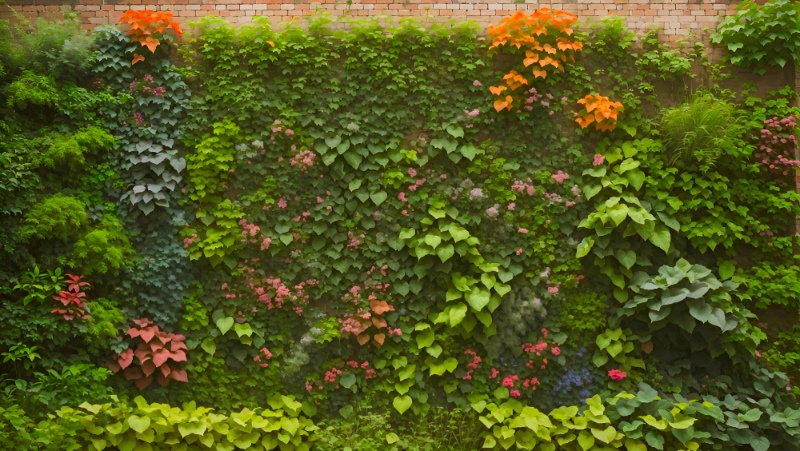How To Make A Living Wall?
What is a living wall? Don’t worry I am not talking any superstitious thing. For many people, living wall is a new phenomenon but it’s not. A living wall can be defined as the arrangement of plants or herbs on your blank wall or unembellished fence. It’s an old concept but due to increased urban life and houses getting smaller, it’s a way in which you can beautify your house, or grow some edibles on your wall vertically. External walls are the good place to start a vertical herb garden design on your wall. It can be arranged in small corridor walls to interior and exterior walls of your home.
Key Points
- Living walls are vertical gardens grown on a wall or surface.
- They purify air, reduce noise, provide insulation, and add natural beauty.
- Living walls can be made indoors or outdoors with proper sunlight and ventilation.
- A sturdy frame, irrigation system, and appropriate plants are needed to create a living wall.
Benefits Of Indoor And Outdoor Living Wall
There are many benefits for such an arrangement of plants in your home. If you are interested in making an indoor living wall, the plants in it helps to purify the air and create a cool and better environment to study, work or live. An outdoor living wall also has many healthy effects, in fact a little more than interior living wall. We all know that there is an excessive level of carbon monoxide and carbon dioxide caused by vehicles in the urban cities. To help minimize these levels into your home, outdoor living wall act as a filter that cleans the air and also absorbs a lot of heat. It also absorbs the loud noises and helps to give you a calm and composed atmosphere for your home.
How To Make A Living Wall?
To know how to make a living wall in your home on a large area, I will recommend that you take help of a specialist. But, if you are looking to create it on a smaller area, then you can follow the steps below:
- Carefully select the space – If you are making it indoor, make sure that a certain level of natural light falls on the wall and the place is properly ventilated.
- Create a solid frame – Be very careful to select the right kind of wood or plastic when you are making a frame. Frame is the important aspect and if it’s shaggy or not fitted well, then it can be dangerous. Also, to make it water proof, make sure you apply the necessary water-proof adhesive and as well cover the frame on its side with a plastic to stop leakage of water.
- Connect all the plants with a small pipe in a series – This is essential so that when you water the plants, you don’t have to reach each and every plant separately. Having a small irrigation system set up on the frame will help you maintain plants in the most convenient and easy way
- Plantation – You can grow some herbs or plants with smaller root system. You can go to a nearby nursery or even in nursery section of Wal-Mart, to get such plants. Upon your description of the frame and space of the living wall, they can advise you best as to which plants or herbs you can grow on it.
- Care – With a living wall, there is minimum care if the plants are getting enough sunlight and essential amount of water. However, make sure that you keep a check on leakage of the frame and add fertilizers whenever needed. You can make use of many natural pesticides too in fact please see the article on how to use garlic as a natural pesticide in our website.
Please Share Your Questions On How To Make A Living Wall.
I hope the steps above are useful and you if you any more questions on how to make a living wall, feel free to comment. We always welcome your suggestions, so don’t forget to leave a feedback.
FAQ
What are the benefits of a living wall?
Living walls purify indoor air, reduce noise, provide insulation, add natural beauty, and allow you to grow plants vertically. They are calming and improve indoor environments.
What is the best location for an indoor living wall?
The best locations have ample indirect sunlight, ventilation, and are structurally sound. Walls in living rooms, bedrooms, offices, and entryways work well. Avoid overly humid spaces.
What type of frame or support system is required?
A sturdy frame made of wood, plastic panels, or metal is required to support the weight of a living wall. It must be securely attached to the wall. Use a waterproof backing layer before attaching planters.
How do you set up irrigation and watering for a living wall?
An irrigation system with drip lines or tubing allows you to easily water the entire wall garden. It waters plants slowly and evenly without runoff.
What are some good plants to use on a living wall?
Succulents, tropical plants, ferns, herbs, and trailing plants with small root systems work best. Choose a mix of cascading, upright, and spreading varieties.
What kind of routine maintenance does a living wall require?
Living walls need frequent watering, fertilizing, pruning, and pest management. Check for leaks, remove dead plants, and trim overgrowth.
How much does it cost to create a living wall?
The cost depends on the size, materials, plants chosen, and whether you install it yourself or hire professionals. Small DIY walls can cost under $100. Large, complex walls can cost over $5,000.
Related posts:




